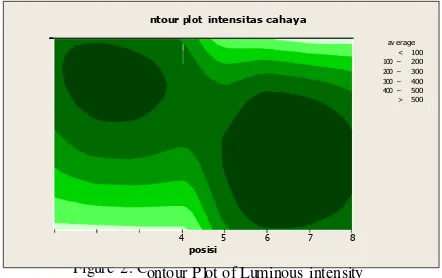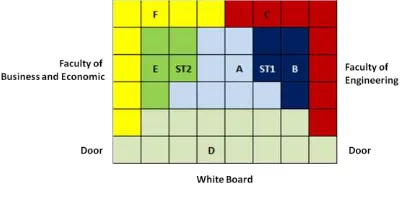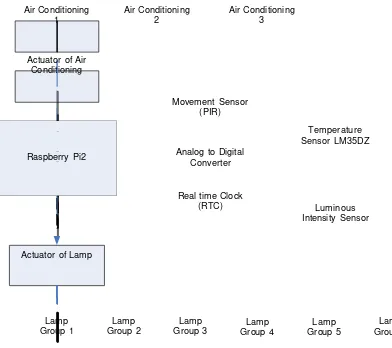8th Widyatama International Seminar on Sustainability
413
Controller System Module as Technology Solution for Realizing Eco-
Campus
R.D Wahyudi
1, S. Wibowo
1, D. N. Prayogo
1, Gunawan
11
Department of Industrial Engineering, Univers ity of Surabaya, Surabaya, Indones ia
I. INT RODUCT ION
Almos t global country agreed that s us tainable development was iss ue des erving to get more attention fro m various society s egments and roles . This awarenes s was cons idered s ince the idea of res ources availability s upporting future human life was increas ingly important. Whereas , afore mentioned resources were able to be threatened
by human’s behavior in daily activities . Thus , every
human had to contribute and be re spons ible for ma intaining s us tainability regardles s of their life’s back ground. In the cas e of univers ity as education ins titution, it was inevitable that univers ity had big role to educate people in s us tainable development awarenes s . Pres ently, many g lob al univers ities have already s tarted imp le menting s us tainable development through eco -campus realization. Des igning eco-campus efforts could be started from clas s , environment, was te treatment, s anitation and other ins tallation. However, eco -ca mpus realizat ion was able to be conducted in s maller s cope firs t s uch as des igning comfortable and good green technology for c las s where the learning proces s took place. According to the aforementioned background, the general purpos e of this paper was to unders tand, s earch for technology s olution and realize eco - campus . Meantime, the s pecific purpos e of this paper was to identify and imple ment technology s olution s uch as controller fo r s upportive learning tools (la mps and air conditioning). Thus , electrical energy efficiency would be achieved by us ing optimu m la mps .
II. M ETHODOLOGY
Res earch conducted was class ified into action res earch (AR) and it us ed s ys tems development (SD) method. Action res earch was a s olid methodology process oriented to participatory and action. Action res earch acted as a s eries of events
and approached for problems s olving. As a problem s olving approach, action res earch was s cientific method imp le mentation s earching facts and e xperimenting practical proble m which needed problem s olving s uch action involving collaboration and cooperation from res earcher and membe r of relevant organization. Dick (2002) argued that action res earch was res earch methodology focused on obtaining dual outcome of res earch and action. This method was not only us ed for s ocial dis ciplines a nd s ociety, but als o in bus iness organization, for s tudy about production and operations management (e.g. Coughlan and Coughlan, 2002), and for informat ion s ys tems (e.g. Grant and Ngwenya ma, 2003). Furthermore, technology s olution development for eco-campus realization was conducted through s everal alternatives . So that, the alternatives needed to be well s elected. In detail, there were two s teps in developing the s olution s uch as meas uring and analyzing the luminous intens ity; and des igning controller s ys tem module.
III. RESULT
1. Lu mi nous In tens ity Me as ureme nt an d An alys is
8th Widyatama International Seminar on Sustainability
414
Co
4.0
3.5
3.0
e t a t2.5
s
2.0
1.5
1.0
1 2 3
Figure 2. C
Bas ed on figure 2 eme rged fro m s o
2 3 6 7
S2 S4
ntour plot intensitas cahaya
av erage < 100 100 – 200 200 – 300 300 – 400 400 – 500 > 500
4 5 6 7 8 posisi
ontour P lot of Luminous intensity
Figure 1 Exist ing Condit ion of Observed Class
Bas ed on the exis ting condition , it was necess ary to analyze the equalization of lu minous intens ity as la mps grouping cons ideration. 48 LED la mps in e xis ting condition were grouped into 4 blocks and controlled by 4 s witches . In term of equalization of lu minous intens ity, meas urement of lu min ous intens ity was conducted in certain points s uch as follows .
, differences in lu minous intens ity me ce rtain areas in clas s room. Thos e diffe rences were probably caus ed by outer corus cation. In cas e of attaining a good luminous intens ity, class participant would congregate in certain area. Thus , the la mp pos ition needed to be cons idered to contribute the over whole lu minous intens ity in clas s room. Whereas , the initia l s etting of s witch s ys tem for la mps was us ing two block s ys tems . Firs t block was us ed for 24 front la mps and s econd block was used for 24 rear la mps . Bes ides the
White board
S1 S3
lu minous intens ity data and s witch s ys tem, other obtained fact was clas s participant deployed unevenly in the clas s room. Therefo re, ignition all of the la mps during clas s activities would be ineffic ient thing. In fact, not only the ignition all of the la mps , but als o the ignition of others s upportive res ources for clas s activities wh ich was in overus ed. In ideal s ituation,
1 4 5 8
the us e of res ources was adapted bas ed on the needs . Therefore, s witching s ystem was rearranged by cons idering the following provis ion:
Data harves ting was conducted by s tudent emp loyee briefed by revealing the goal and s tep of this res earch. Thus , they knew about their role and contribution. Lu minous intens ity meas urement was noted and dis played as intens ity dis tribution in contour plot for large roo m and s mall room. It was graphically pres ented by figure 2.
There are 2 clas s s ides having numbers of
window s o the outer light is able to penetrate the clas s s ince morn ing to evening
Clas s front s ide, place for LCD Projector,
needs higher lu minous intens ity than the place where s tudents s eat in order the s tudents will get clea r appearance
Fore mos t s eats are exactly placed under the
third-row la mp counting fro m front s ide
Clas s s ide which is windowles s , es pecially
8th Widyatama International Seminar on Sustainability
and controlled by 6 s witches
Lu minous intens ity for place where s tudents
8th Widyatama International Seminar on Sustainability
416
Raspberry Pi2
Roo m controlle r module was able to be connected with s everal s ens or (s uch as temperature and light s ens or), s everal actuator (s uch as lamps and air condition ing unit), and s erver computer us ing wireles s commun ication
and LAN (Local Area Network ). Bas ed on the
comparis on above, Ras pberry Pi2 was chos en as us ed hardware module controlling the room. The ma in cons ideration was Ras pberry had higher clock s peed, able to us e micro SD card to s ave a huge me mory, had Ethernet port, had high RAM (1GB), had many digita l IOs (26 units ) and had equal price with others
3. Imple me nt ati on
The mechanis m of module after being imp le mented was e xpla ined by follo wing flo wchart:
TABLE 2. MEASUREMENT OF ELECTRICAL ENERGY
Lamp Air Condit ioning
No Controller Module
Using Cont roller Module
No Cont roller Module
Using Controller Module
1.4 1.1 90 64.1
2.8 1.7 76.2 61.5
0.6 0.7 68.1 65.6
1.8 2.9 38.5 62.3
IV. CONCLUSION
Realizing eco-s us tainable campus through technology s olution des ign was conducted by des igning controlling s ys tem to control ON/OFF s ys tem for la mps and air conditioning bas ed on clas s room condition, availability of people in room which was detected by PIR motion s ens or. By us ing this controller s ys tem, ignit ion of la mps and air conditioning was bas ed on the needs . Thus , it would res ult the s ignificant reduction of energy us e during
Air Conditioning 1
Actuator of Air Conditioning
Air Conditioning
2 Air Conditioning 3 the class activities . The alternative module s election
process and module d es ign was conducted bas ed on literature s tudy and experiment.
Movement Sensor (PIR)
Actuator of Lamp
Analog to Digital Converter
Real time Clock (RTC)
Temperature Sensor LM35DZ
Luminous Intensity Sensor
REFERENCE
Coughlan, P. and Coghlan, D. (2002) Action res earch for operations management, International Journal of Operations & Production
Lamp Group 1
Lamp Group 2
Lamp
Group 3 Group 4 Lamp Group 5 Lamp Lamp Group 6
Dic k, B. (2002) Pos tgraduate programs us ing action res earch, The Learning Organization, 9 (4),
Figure 4. Flowchart of cont roller module mechanism
Bas ed on the s chedule of clas s room activit ies , it was dis covered that the class which was facilitated by 48 units of 14W LED La mps was us ed every day from 07.00 to 18.30. In this s ituation, the electrical energy was meas ured when controller module was not us ed and was us ed. Harves ting data was conduct ed in a week for controlle r module was not us ed and a week for controller module was us ed . The obtained data was pres ented on Table 2.
159-170
Grant, D. and Ngwenyama, O. (2003) A report on the us e of action res earch to evaluate a manufacturing information s ys tems development methodology in a company,


